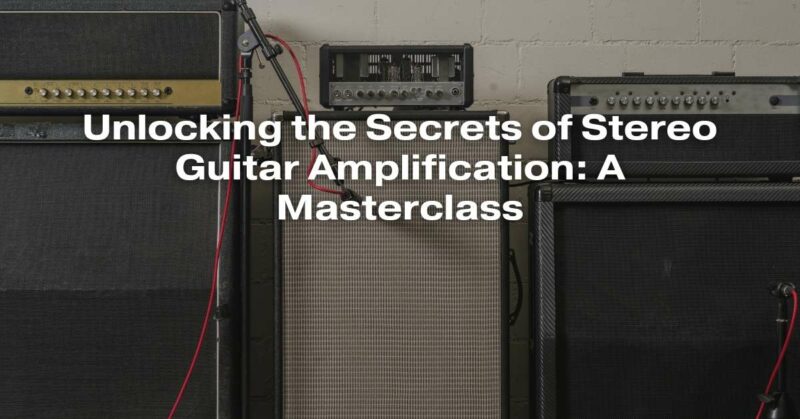Guitar amplification has come a long way since its inception, with musicians continually pushing the boundaries to achieve the ultimate tone. One of the most captivating and immersive ways to experience guitar sounds is through stereo guitar amplification. This technique utilizes two separate amplifiers and speakers to create a rich, three-dimensional soundstage that can transport listeners to new sonic realms. In this masterclass, we will delve into the secrets of stereo guitar amplification, exploring its history, benefits, gear requirements, and tips for achieving a breathtaking stereo guitar tone.
The Evolution of Stereo Guitar Amplification
Stereo guitar amplification is not a recent innovation. Musicians have been experimenting with stereo setups for decades. Iconic guitarists like Jimi Hendrix and David Gilmour were among the early pioneers who explored the possibilities of stereo amplification in their live performances and studio recordings. Over the years, advancements in technology have made it more accessible and versatile for modern guitarists to harness the power of stereo sound.
Benefits of Stereo Guitar Amplification
1. Enhanced Soundstage
The primary allure of stereo guitar amplification is the vast soundstage it creates. By splitting your guitar signal into two separate amplifiers and speakers, you can achieve a spatial depth and width that is impossible to replicate with a mono setup. This expansive soundstage allows for greater sonic immersion, making it perfect for live performances or studio recordings where depth and width are essential.
2. Versatility
Stereo setups are incredibly versatile. They can accommodate a wide range of musical styles and genres. Whether you’re playing clean, crunchy, or heavily distorted tones, stereo amplification can provide the dynamic range and clarity needed for your guitar to shine through the mix.
3. Depth and Dimension
Stereo guitar amplification creates a three-dimensional audio experience. The spatial separation between the two amplifiers allows you to manipulate the positioning of your guitar in the mix. This added depth and dimension can make your playing more expressive and captivating.
4. Inspiring Creativity
The unique sonic possibilities of stereo setups can inspire creativity and experimentation. Musicians can explore different textures, tones, and effects that may not be achievable in a mono configuration. This can lead to innovative and groundbreaking musical compositions.
Gear Requirements for Stereo Guitar Amplification
To unlock the secrets of stereo guitar amplification, you’ll need the right gear. Here’s a list of essential components:
1. Two Amplifiers
The foundation of any stereo setup is two separate amplifiers. These amplifiers should have similar power ratings and tonal characteristics. Tube amplifiers are often preferred for their warmth and harmonically rich overtones.
2. Two Speakers
Matching speakers are crucial for a balanced stereo sound. Ideally, you should use two identical speaker cabinets with the same type and size of speakers. This ensures consistent tonal quality from both amplifiers.
3. Stereo Effects
Stereo effects pedals play a pivotal role in shaping your stereo guitar sound. Devices like stereo delay, reverb, and modulation pedals can add depth and width to your tone. These effects should be placed in your signal chain after your guitar but before the amplifiers.
4. A/B/Y Switch
An A/B/Y switch is essential for routing your guitar signal to both amplifiers simultaneously. This device allows you to easily switch between mono and stereo configurations.
5. Mixer or Switcher
A mixer or switcher can help you balance the levels of each amplifier and manage your stereo effects. It’s a useful tool for fine-tuning your stereo sound and achieving the desired spatial characteristics.
Tips for Achieving a Breathtaking Stereo Guitar Tone
1. Balance Your Amplifiers
Achieving a balanced sound between your two amplifiers is crucial. Use the A/B/Y switch to compare the levels and adjust the gain, volume, and EQ settings on each amplifier until they match as closely as possible.
2. Experiment with Panning
The positioning of your amplifiers on stage or in the studio can impact the stereo image. Try different placements to find the sweet spot that gives you the desired spatial depth.
3. Dial in Your Effects
Stereo effects pedals should be carefully dialed in to enhance your sound without overwhelming it. Experiment with delay and reverb settings to find the perfect balance between spaciousness and clarity.
4. Record in Stereo
In the studio, recording your stereo guitar setup with two microphones (one for each amplifier) can capture the full stereo spectrum. This adds depth and dimension to your recordings and allows for more creative mixing options.
5. Listen and Refine
Stereo guitar amplification is a journey of discovery. Take the time to listen to your sound, both in a band context and solo, and make adjustments as needed. Fine-tuning your stereo setup is an ongoing process that can lead to incredible results.
Conclusion
Unlocking the secrets of stereo guitar amplification is a journey that can take your guitar playing to new heights. By harnessing the power of stereo sound, you can create a captivating and immersive sonic experience that engages your audience and inspires your creativity. With the right gear, careful balancing, and a willingness to experiment, you can unlock the full potential of stereo guitar amplification and embark on a sonic adventure that sets your music apart from the rest. So, plug in, turn up, and explore the endless possibilities of stereo guitar amplification – your ears will thank you.


